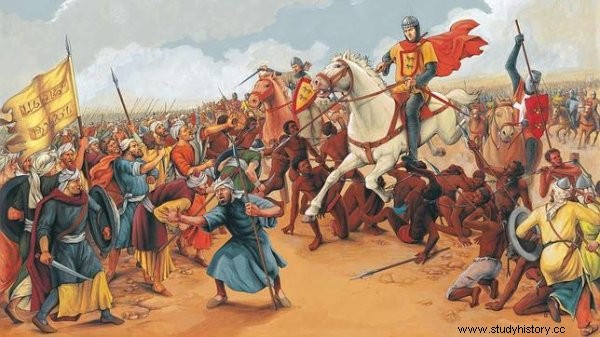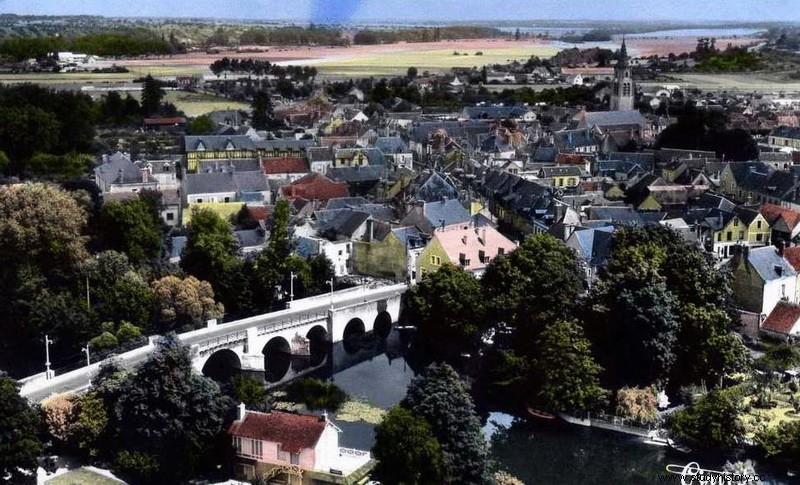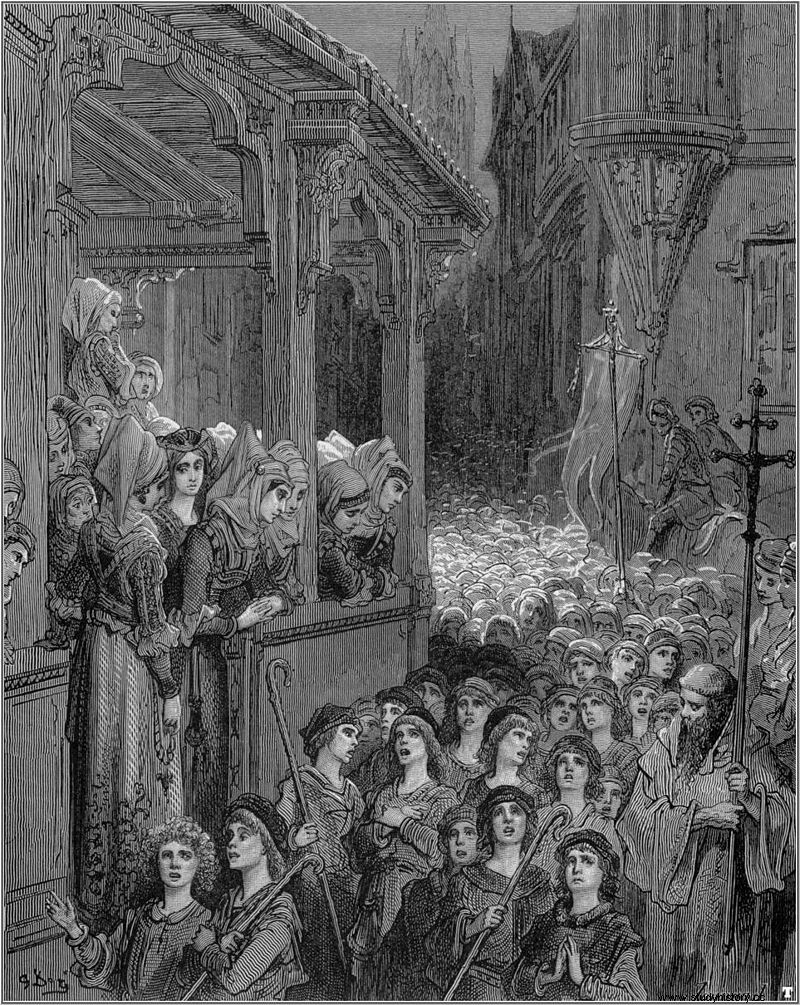In 1212, just eight years after the knights of the Fourth Crusade sacked Constantinople, a group of thirty thousand children crossed half of Europe on their way to Jerusalem. His mission, entrusted by Jesus Christ through an apparition, was to reconquer the Holy City, under Muslim control. The episode, which went down in history as the Children's Crusade , was collected by fifty chroniclers of the time, among whom are such reliable and reputable sources as the theologian Roger Bacon, the Dominican Vincent de Beauvais, author of the work Speculum Majus , or the also theologian Tomás de Cantimpré. However, this episode never took place... or at least not in the way it was told.
The historical context
Sometimes, an erroneous interpretation of the sources can lead to accepting as certain events that never happened, or that they happened in a very different way than we believe. And the case of the Children's Crusade is a good example of this. The events (however they happened) took place at the beginning of the 13th century in Europe. The spirit of the Crusades (well nourished by the Church) flooded everything. Or, at least, everything that the territorial wars could not destroy. In that sense, the year 1212 was not proving to be boring.
In the Iberian Peninsula the Christian kingdoms were quite busy with the Almohads of Al-Andalus. In fact, while the episode that concerns us today was taking place in France and Germany, the kings of Castile, Navarre and Aragon faced the caliph an-Nasir, Miramamolín by bad name, in the Navas de Tolosa .

The King of France, Felipe II, better known as Felipe Augusto, had turned to the war against Juan sin Tierra (John I of England) and to conquer and maintain the territories that the Plantagenets possessed in France, and the Holy Roman Empire. he was immersed in succession struggles for the title of King of the Romans between Otto IV and Frederick Hohenstaufen, the future Frederick II. Fights to which, by the way, Felipe Augusto was no stranger either. No, Europe was not in for much joy.
Innocent III
And it cannot be said that Pope Innocent III mediated to achieve peace on the continent. A few years earlier he had proclaimed the Fourth Crusade, which much to his regret had led to the conquest and looting of Constantinople (still a Christian city, capital of the Byzantine Empire), with the intention of recovering Jerusalem, which had remained under Muslim control after the agreement signed between Richard the Lionheart and Saladin at the end of the Third Crusade. He had also ordered the burning alive of thousands of European heretics in the Albigensian Crusade, causing terror among the Cathar population of southern France, an affair that ended in 1213 with the taking of Béziers and the papal legate pronouncing the famous phrase…
Kill them all, God will recognize his own.
As if these credentials were not enough, Innocent III provoked the succession wars in the Holy Roman Empire with his pretensions to create a theocratic government in Europe, headed, of course, by himself.
The Children's Crusade:what tradition tells us
This is how Europe was when this story begins, in 1212, in the small French village of Cloyes-sur-le-Loir . Cloyes is a beautiful town on the banks of the Loire River that today has less than three thousand inhabitants. So imagine what it was like in the early 13th century.

The protagonist is a little twelve-year-old shepherd, Étienne (the French equivalent of Stephen ). In the month of June little Stephen has a vision:Jesus Christ urges him to write a letter to the king of France asking him to lead a new crusade for the liberation of the Holy Land. Philip Augustus, who had personally participated in the Third Crusade two decades before with Richard the Lionheart without achieving anything, and engaged as he was in his war with the Plantagenets, completely ignored little Stephen's letter. In fact, what is surprising is that the pastor managed to get it to him. The point is that after the king's refusal to Stephen, Jesus appears again, but this time with a different message:he will be in charge of leading a crusade made up of children to liberate the Holy City. The divine power will open the waters of the Mediterranean so that they can cross it, as happened with Moses, and Jerusalem will fall under the power of the purity of their souls and her goodness.
The German branch
A few weeks before Esteban was given the message from him another little shepherd, Nicolas , this time from the Rhineland region in Germany, he receives a similar commission and begins to preach it throughout the region, finally converging in the city of Cologne together with thousands of children who heard his message. And they set off across the Alps, heading for Italy. A difficult road, as you can imagine, even in summer. Many died and many others turned back to their homes. That the life of a shepherd or a peasant was very difficult at the beginning of the 13th century, but we are always on time to die, they must have thought. The fact is that about seven thousand arrived in Genoa at the end of August. They headed to shore and waited for the waters to part before they crossed to their destination.
The end of the Children's Crusade
Meanwhile, Esteban had managed to round up about thirty thousand children and they headed south to the Mediterranean coast. On their way they were living on the charity of the towns they passed through, but there were too many mouths to feed:many died of hunger and, like the German children, many others returned home.

The Children's Crusade, print by Gustave Doré
Less than two thousand finally reached the coast, where they began to pray from sunrise to sunset, waiting for the waters to part. But the miracle did not come. After several days praying, some merchants offered them their boats to move to Jerusalem. Esteban and his followers, grateful, thought they saw the promised miracle in the gesture and confidently embarked. However, the ships headed for Alexandria, where the children were sold into slavery. Years later one of these children, already an adult, would manage to return to France and tell his story.
Nicolás and his people did not do too well either. The Genoese authorities took pity on them and offered citizenship to those who wanted to settle there. And many did, but Nicholas and his most faithful followers did not want to give up and continued on their way to the Papal States, where Innocent III received them, exhorting them to return to their families. They did not survive a second trip across the Alps.
The reality
It's strange how one word can change everything. Pueri , in this case. At the beginning of the 13th century, Europe was filled with vagabonds. Not only because of wars, which were constant and widespread as we have seen at the beginning, but also (and above all) because of economic changes. The rural population had greatly increased, yet improvements in agriculture since the end of the 12th century (the mouldboard plough, crop rotation, and the use of water and windmills, the latter brought to Europe by the Crusaders ) made so much labor unnecessary.

This meant that many peasants, entire impoverished families, especially in France and Germany, had to sell their land and head for the cities, wandering in groups and living on charity. Soon these groups of vagabonds became known as pueri (from Latin, children) condescendingly. Thus, these pueri (among which there were children, but also adults), they wandered from city to city, saying prayers. Years later, even in the same century, the chroniclers who read these stories did not know how to give the correct interpretation to the term, whose figurative meaning had already been lost. Thus began a legend that has even entered folklore:surely reading this story has brought to mind a certain tale starring a flutist. And all for a word taken literally.
Collaboration of Enrique Ros of History Notes
